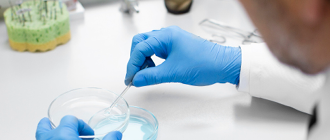Endocrine disruptors are a large family of compounds that can interact with the hormonal system. These compounds can potentially affect different functions of the body such as metabolic functions, reproductive functions, the central nervous system, etc.
The sources of exposure are difficult to identify and the biological consequences are still poorly understood and complex to determine. This is why the study of endocrine disruptors represents a major challenge for the cosmetics industry, which must assess the safety of the product by proving its harmlessness.
The Tame-Water laboratory has therefore developed specific bioassays that allow it to analyze the acute or chronic toxicity induced by these substances, taking into account potential cocktail effects.
Endocrine disruption analysis benefits
Use of in-vitro cell models
The effect of an endocrine disruptor can be assessed at different biological scales, from the cell to the organism. Thus, there are two distinct models :
- In vivo models
- In vitro cellular models
Tame-Water has analyses based on in vitro cellular models to meet the challenges of the cosmetic market.
These models have several specific advantages :
- A sensitivity recognized by scientific committees
- Reduced analysis time
- Lower costs, as they are optimized
- Tests are not performed on animals
Tame-Water's cellular models are able to evaluate an effect in a few hours. They allow for rapid analysis of ingredients, with complete reliability and relevance. Finally, these single-cell models are not considered as animal testing, which meets the ethical considerations of the sector.
Regulations, certifications and labels
The specific "endocrine disruptors" bioassays proposed by Tame-Water allow cosmetic actors to comply with regulations and to obtain specific labels.
Environmental impact assessment
The endocrine disruptors present in cosmetics represent a very large diversity of substances, both in terms of chemical structures and biological modes of action.
This diversity of molecules poses a real challenge in terms of identification of endocrine disruptors. It is often difficult to prioritize the molecules to be monitored.
Tame-Water's Bioassay analytical approach allows the evaluation of the impacts of endocrine disruption on living organisms. Thus, rather than looking for a molecule, bioassays will allow to evaluate the potential toxicity of a substance or a complex formulation.
Reformulation & ingredient substitution
These analyses provide R&D departments with valuable assistance in designing their formulas. Indeed, based on these results, the cosmetics sector has the necessary insight to validate or adapt their formulas with alternative ingredients that have less impact on the environment.
Resources
Tame-Water has been implementing for many years various bioassays for the detection of impacts on living organisms. These analytical services include the biological detection of steroidal or thyroidal endocrine disruptors.
These tests are based on the in vitro use of human cells (MELN, U2OS and HG5LN-TR) equipped with reporter genes allowing the emission of a luminous signal directly dependent on the activation of the hormone receptors of interest.
Thyroid disruption test
Thyroid disruption is determined on the HG5ln cell model
Principle :
- This test uses a cervical cancer cell line (HeLa).
- Upon contact with thyroid disruptors, these cells equipped with reporter genes catalyze a luminescent reaction
- Luminescence measurements are performed after 2 days of exposure to the test substances or samples.
Estrogenic disruption test
Estrogenic disruption is determined on the MELN cell model developed by the team of Pr Balaguer (INSERM U540, Montpellier)
Principle :
- This test uses a human breast cancer cell line (MCF-7)
- In contact with estrogenic disruptors, these cells equipped with reporter genes catalyze a luminescent reaction.
- The emission of light is proportional to the amount of substance binding to the receptor.
- Luminescence measurements are performed after 3 days of exposure to the test substances or samples.
Androgenic disruption test
The androgenic disturbance is determined on the U2OS cell model
Principle :
- This test uses a human cell line in which the androgen receptor gene has been coupled to a so-called reporter gene coding for luciferase.
- In contact with androgenic disruptors, these cells equipped with reporter genes catalyze a luminescent reaction.
- The emission of light is proportional to the amount of substance binding to the receptor.
- Luminescence measurements are performed after 24 hours of exposure to the test substances or samples.
YES/YAS test, estrogenicity and androgenicity on baker's yeast (Saccharomyces cerevisiae)
This test is based on the following effects:
- Activation or inhibition of the human estrogen receptor (YES test, estrogenic or anti-estrogenic effects)
- Activation or inhibition of the human androgen receptor (YAS test, androgenic or anti-androgenic effects)











